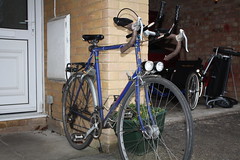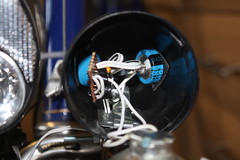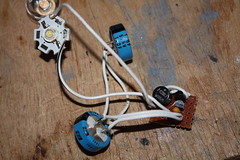spinningcog
Newly Enlightened
- Joined
- Oct 9, 2011
- Messages
- 3
I have a 1972 Schwinn Twin that I've been fixing up to make the ultimate around town bike. I've updated the equipment where it makes the bike more enjoyable to use, but have tried to keep most of the original look.
To that end I've installed the Sturmey Archer XL-FDD dyno/drum break hub in the front wheel.
I've acquired an vintage bullet style light to run off the dyno hub. The optics of the bullet light where designed for an incandescent bulb so will be sub optimal for an LED emitter - furthermore they will only accommodate a single light source - so I will only use one LED as opposed to most other designs that utilize multiple LED's. The usage of a single LED simplifies the needs of the driver circuit since it will no longer require a voltage doubler which is usually necessary to get good low speed performance.
I have (very) little electronic experience but have reviewed a number of the circuits for powering LED lights off dynamo's that have been posted here. In particular Martin's (no. 7) and Steven K's designs have been of interest.
http://www.flickr.com/photos/kurtsj00/5420960597/in/set-72157621965148305
and
http://pilom.com/BicycleElectronics/DynamoCircuits.htm
While circuit 7 meets my needs for driving a single LED efficiently it has no stand light feature. I've thought about increasing the value of C1 with a super capacitor (maybe 1F?) to provide the circuit with the ability to store energy, but I'm unable to conclude if that would indeed function as a stand light or if it would just discharge so rapidly as to be essentially useless. Additionally I am unable to break apart Steven K's circuit design to utilize just the NiCad charging/discharging portion.
If I could get some help with a circuit design that would meet my needs (Good output with a single LED (Cree XM-L?) with a stand light.) It would be greatly appreciated!
-Will
To that end I've installed the Sturmey Archer XL-FDD dyno/drum break hub in the front wheel.
I've acquired an vintage bullet style light to run off the dyno hub. The optics of the bullet light where designed for an incandescent bulb so will be sub optimal for an LED emitter - furthermore they will only accommodate a single light source - so I will only use one LED as opposed to most other designs that utilize multiple LED's. The usage of a single LED simplifies the needs of the driver circuit since it will no longer require a voltage doubler which is usually necessary to get good low speed performance.
I have (very) little electronic experience but have reviewed a number of the circuits for powering LED lights off dynamo's that have been posted here. In particular Martin's (no. 7) and Steven K's designs have been of interest.
http://www.flickr.com/photos/kurtsj00/5420960597/in/set-72157621965148305
and
http://pilom.com/BicycleElectronics/DynamoCircuits.htm
While circuit 7 meets my needs for driving a single LED efficiently it has no stand light feature. I've thought about increasing the value of C1 with a super capacitor (maybe 1F?) to provide the circuit with the ability to store energy, but I'm unable to conclude if that would indeed function as a stand light or if it would just discharge so rapidly as to be essentially useless. Additionally I am unable to break apart Steven K's circuit design to utilize just the NiCad charging/discharging portion.
If I could get some help with a circuit design that would meet my needs (Good output with a single LED (Cree XM-L?) with a stand light.) It would be greatly appreciated!
-Will




